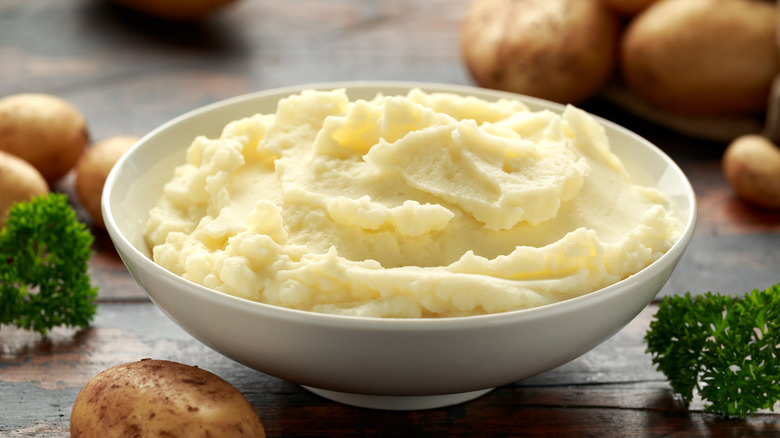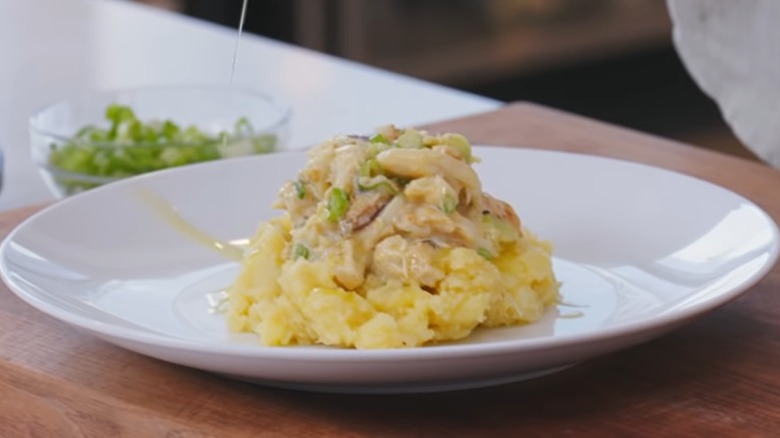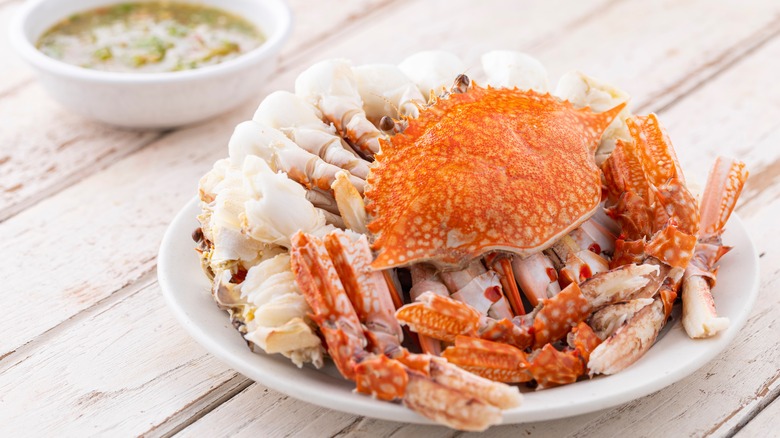You Should Really Be Adding Crab Fat To Your Mashed Potatoes
Mashed potatoes are one of those dishes that follow the rule of "what you see is what you get." You're getting a plate full of potatoes peeled and smashed until fluffy, smooth, and creamy — nothing more, nothing less. Although mashed potatoes are undoubtedly popular to serve alongside a tender, gravy-soaked piece of roast beef or smothered on top of a shepherd's pie, mashed potatoes can sometimes fall under the unfortunate stereotype of being bland or flavorless.
Fortunately, one significant advantage of mashed potatoes is that they're receptive to any sort of toppings or add-ins, whether salty or savory. You could add bacon, cheese, and green onions to make loaded mashed potatoes. To give your potatoes a savory yet subtly sweet taste, you could mix in some caramelized onions and garlic. If you're looking for a smoother mashed potato, take Swanson's advice and mix in chicken broth and heavy cream. You could even use something as simple as butter, salt, and pepper to turn dry, flavorless potatoes into something creamy and rich.
But one thing you probably never associate with mashed potatoes is crab. What benefits does crab fat give your mashed potatoes, and how can you be sure it won't give your potatoes an overpowering seafood flavor?
You can serve crab salad on your mashed potatoes
While taking a bite of mashed potatoes and discovering it tastes like a crab dinner would be surprising, this particular recipe puts the mashed potatoes as a foundation for crab salad rather than straight crab blended right into the mashed potatoes themselves.
As Melissa Miranda of Bon Appétit explains, the main star of the recipe is homemade crab salad served over crab-fat-infused mashed potatoes. Miranda first prepares a crab fat oil, blending the freshly extracted crab fat with confit garlic — garlic cooked and preserved in olive oil – and seasoning salt until the fat and oil have combined and the mixture has rendered down. Miranda then makes a crab salad, combining vegan mayo, mustard, scallions, Giannis, lemon juice, and crab meat. Her mashed potatoes, which will serve as the starchy foundation, are prepared rustic-style, meaning she mashes the cooked potatoes with a fork to keep them from getting too creamy. Miranda adds the crab fat mixture and garlic to the potatoes before plating and serving with the crab salad.
The result, Miranda tells us, should be a rich crab flavor that is enhanced by (but not competing with) the creaminess of the confit garlic and the fresh bite of the potatoes and scallions.
What is crab fat anyway?
You might imagine a chewy, malleable pink cube of pure congealed substance when you think of fat, such as beef or pork fat. While that may apply to cows and pigs, crab fat is somewhat different. It's not so much fat as it is a combination of the crab's digestive gland and other assorted innards that forms a fatty, flavorful compound when cooked. It's also known as the tomalley, though others call it crab fat or lobster concentrate due to its intense flavor.
While crab fat can be purchased online through retailers like Amazon, it is possible to get it directly from the source — provided you're not squeamish. According to one Reddit user in the Pacific Northwest, crab fat can easily be removed by tearing off the crab shell.
"Here in the Pacific Northwest, we catch Dungeness crab by the dozen," the user explains. "Boil them up in ocean water, crack the top shell off upside down to collect the body butter, strip the meat off, throw it in the top shell, and toss around said body butter. Absolutely delectable."
If you're not exactly the type of person to tear off shells from seafood, you can ask your local seafood vendor or butcher (should they deal in seafood) to extract the crab's innards for you. Just don't get crabby if you have to do it yourself!


